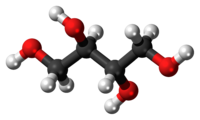Erythritol
 |
|
 |
|
| Names | |
|---|---|
|
Systematic IUPAC name
(2R,3S)-Butane-1,2,3,4-tetrol
|
|
| Other names
(2R,3S)-Butane-1,2,3,4-tetraol (not recommended)
|
|
| Identifiers | |
|
149-32-6 |
|
| 3D model (Jmol) |
Interactive image Interactive image |
| ChEBI |
CHEBI:17113 |
| ChEMBL |
ChEMBL349605 |
| ChemSpider |
192963 |
| DrugBank |
DB04481 |
| ECHA InfoCard | 100.005.217 |
| E number | E968 (glazing agents, ...) |
| KEGG |
D08915 |
| PubChem | 222285 |
| UNII |
RA96B954X6 |
|
|
|
|
| Properties | |
| C4H10O4 | |
| Molar mass | 122.12 g·mol−1 |
| Density | 1.45 g/cm3 |
| Melting point | 121 °C (250 °F; 394 K) |
| Boiling point | 329 to 331 °C (624 to 628 °F; 602 to 604 K) |
| -73.80·10−6 cm3/mol | |
| Hazards | |
| NFPA 704 | |
|
Except where otherwise noted, data are given for materials in their standard state (at 25 °C [77 °F], 100 kPa).
|
|
|
|
|
| Infobox references | |
Erythritol ((2R,3S)-butane-1,2,3,4-tetraol) is a sugar alcohol (or polyol) that has been approved for use as a food additive in the United States and throughout much of the world. It was discovered in 1848 by Scottish chemist John Stenhouse. It occurs naturally in some fruit and fermented foods. At the industrial level, it is produced from glucose by fermentation with a yeast, Moniliella pollinis. Erythritol is 60–70% as sweet as sucrose (table sugar) yet it is almost noncaloric, does not affect blood sugar, does not cause tooth decay, and is partially absorbed by the body, excreted in urine and feces. Under U.S. Food and Drug Administration (FDA) labeling requirements, it has a caloric value of 0.2 calories per gram (95% less than sugar and other carbohydrates), though nutritional labeling varies from country to country. Some countries, such as Japan and the United States, label it as zero-calorie, while the European Union currently labels it at 0 cal/g.
In the body, most erythritol is absorbed into the bloodstream in the small intestine, and then for the most part excreted unchanged in the urine. About 10% enters the colon. Because 90% of erythritol is absorbed before it enters the large intestine, it does not normally cause laxative effects, as are often experienced after consumption of other sugar alcohols (such as xylitol and maltitol), although extremely large doses can cause nausea and borborygmi (stomach rumbling).
In general, erythritol is free of side effects in regular use. Doses over 50 grams (1.8 oz) can cause a significant increase in nausea and stomach rumbling. Rarely, erythritol can cause allergic hives (urticaria).
...
Wikipedia

